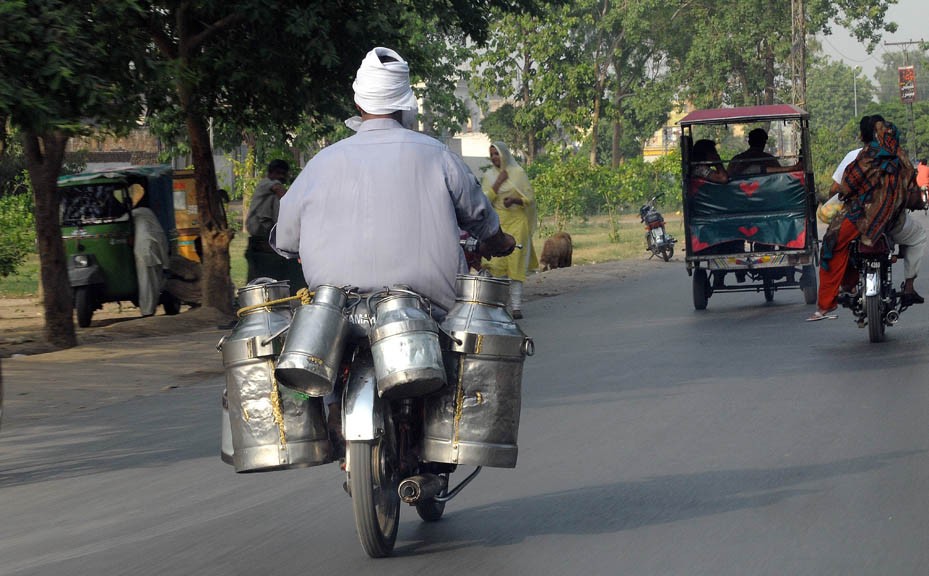
Whereas getting hygienic loose milk is a problem, the real story is way more twisted. For this we need to go back to the local dairy farms

"The milk you’re selling is barely milk; there’s so much water in it!" We have heard this so many times that it has almost become clichéd now. But the fact remains that this is still the story of almost every other household in Lahore. Our folks are constantly worrying about where to get hygienic loose milk from, how much to trust your local vendor -- usually the milkman (or gawala, in vernacular); and whether to go for branded products or not.
However, this is just the surface. The real story is way more twisted and scary. For this we need to go back to where milk is produced -- the local dairy farms. Here, the farmers toil all year round, raising their cattle, fighting different diseases that affect the animals, all by themselves, with little or no assistance from the government. From antibiotic injections to food to transportation, the farmer pays for it all. In return, all he wants is a suitable price for his dairy products. And this is where the problem begins.
In a recent online presentation, Prof Dr Talat Naseer Pasha, Vice Chancellor, UVAS, Lahore, wrote that the production cost of 80 per cent milk produced at rural farms is approximately Rs83.8 per litre. The government, on the other hand, has set the sales price at Rs40-42 per litre, which means that the farmers are only able to recover half of the total cost, let alone making any profits.
Secondly, the milk which is sold by the farmers is at the mercy of the gawalas who carry it from the farms all the way to the nearby cities. One gawala, who fetches milk from Kasur, tells TNS that he has to pass through various checkposts before he reaches Lahore with his milk supply. At every checkpost, he says, he has to either offer a litre or so of milk, or part with some money. This obviously means that the per-litre cost of milk would go further up.
When prompted, the gawala confesses that he often resorts to ‘adulteration’ in order to make both the ends meet. The idea is to increase the volume of milk unnaturally. This commonly entails adding water to milk, but there are milkmen/vendors who often mix starch which increases the consistency of milk and makes it appear thicker. Some even add detergents in a bid to imitate the frothiness of pure milk. Still other impurities include whey powder, vegetable oil and artificial milk powder. All this renders loose milk harmful for health, especially for kids whose primary diet is milk.
The problem arises because of the inability of the farmers and milk vendors to cover their costs.
The increased cost of milk production and cattle rearing has adversely affected livestock farming. According to an official (who refused to be named) at Punjab Livestock and Dairy Development Department, the current population of cattle in Pakistan is 23.34 million and that of buffaloes is 22.42 million. This is less than what we saw in 2006.
The official says that the reason why the farmers are unable to meet the cost of producing milk is that the government has fixed the sale price (for farmers) at Rs45-55 per litre. The production cost per litre is Rs80-85.
This has forced the farmers to either give up milk production or add water and/or impurities to increase the volume of the yield.
The official also says that the government should not set a minimum price for dairy products, especially milk, "It should let the market determine the price instead.
"Sure it will trigger a price hike, initially, but eventually the demand and supply are the real and most effective price regulators."
He urges on the government to step in and ensure that the farmers not only cover their actual cost but also make some profits from their produce.
Elaborating on the point he says, "Once the farmers are able to make profits on their produce, they shall work in a more professional manner. Thus, livestock farming will become a lucrative investment like it once was. As the number of milk producing animals increases, there will be surplus milk. The greater the supply, the better the prices.
"This could act as a two-way solution: Better quality milk will become available to people at an affordable price, and the number of livestock farms shall increase in your neighbourhood. The farmers shall start to rear more cattle, thereby giving impetus to the country’s milk yield manifold."